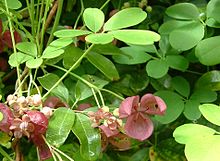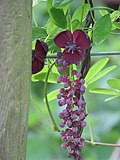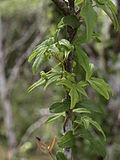Lardizabalaceae
- View a machine-translated version of the Spanish article.
- Machine translation, like DeepL or Google Translate, is a useful starting point for translations, but translators must revise errors as necessary and confirm that the translation is accurate, rather than simply copy-pasting machine-translated text into the English Wikipedia.
- Do not translate text that appears unreliable or low-quality. If possible, verify the text with references provided in the foreign-language article.
- You must provide copyright attribution in the edit summary accompanying your translation by providing an interlanguage link to the source of your translation. A model attribution edit summary is
Content in this edit is translated from the existing Spanish Wikipedia article at [[:es:Lardizabalaceae]]; see its history for attribution. - You may also add the template
{{Translated|es|Lardizabalaceae}}to the talk page. - For more guidance, see Wikipedia:Translation.
| Lardizabalaceae Temporal range: 120–0 Ma PreꞒ Ꞓ O S D C P T J K Pg N | |
|---|---|
 | |
| Akebia quinata | |
| Scientific classification | |
| Kingdom: | Plantae |
| Clade: | Tracheophytes |
| Clade: | Angiosperms |
| Clade: | Eudicots |
| Order: | Ranunculales |
| Family: | Lardizabalaceae R.Br.[1] |
| Genera | |
| See text | |
| Synonyms | |
| |
Lardizabalaceae is a family of flowering plants.
The family has been universally recognized by taxonomists, including the APG II system (2003; unchanged from the APG system of 1998), which places it in the order Ranunculales, in the clade eudicots.
The family consist of 7 genera with about 40 known species[2][3] of woody plants. All are lianas, save Decaisnea, which are pachycaul shrubs. The leaves are alternate, and compound (usually palmate), with pulvinate leaflets. The flowers are often in drooping racemes.
They are found in eastern Asia, from the Himalayas to Japan, with the exception of the genera Lardizabala and Boquila, both native to southern South America (Chile, and Boquila also in adjacent western Argentina). The extinct genus Kajanthus is known from the Early Cretaceous of Portugal.[4]
Genera
| Image | Genus | Common name | Number of living species |
|---|---|---|---|
 | Akebia Decne. | Chocolate vine | 5 |
 | Boquila Decne. | Chameleon vine | 1 |
 | Decaisnea Hook.f. & Thomson | Dead man's fingers | 1 |
 | Lardizabala Ruiz & Pav. | Zabala fruit | 1 |
 | Sargentodoxa Rehder & E.H.Wilson | 1 | |
 | Sinofranchetia Hemsl. | 1 | |
 | Stauntonia DC. | 16 |
References
- ^ Angiosperm Phylogeny Group (2009). "An update of the Angiosperm Phylogeny Group classification for the orders and families of flowering plants: APG III" (PDF). Botanical Journal of the Linnean Society. 161 (2): 105–121. doi:10.1111/j.1095-8339.2009.00996.x. hdl:10654/18083. Retrieved 2013-07-06.
- ^ Christenhusz, M. J. M. (2012). "An overview of Lardizabalaceae". Curtis's Botanical Magazine. 29 (3): 235–276. doi:10.1111/j.1467-8748.2012.01790.x.
- ^ Christenhusz, M. J. M.; Byng, J. W. (2016). "The number of known plants species in the world and its annual increase". Phytotaxa. 261 (3): 201–217. doi:10.11646/phytotaxa.261.3.1.
- ^ Mendes, Mário Miguel; Grimm, Guido W.; Pais, João; Friis, Else Marie (2014-10-02). "Fossil Kajanthus lusitanicus gen. et sp. nov. from Portugal: floral evidence for Early Cretaceous Lardizabalaceae (Ranunculales, basal eudicot)". Grana. 53 (4): 283–301. doi:10.1080/00173134.2014.932431. ISSN 0017-3134.
External links
 Media related to Lardizabalaceae at Wikimedia Commons
Media related to Lardizabalaceae at Wikimedia Commons- Lardizabalaceae in the Flora of North America
- Lardizabalaceae in the Flora of China
- links at CSDL
- Chilean Lardizabalaceae at Chileflora
- v
- t
- e
- Supergroup Plant:
- Bryophyta
- Marchantiophyta
- Polypodiophyta
- Acrogymnospermae
- Angiospermae
| Amborellales | |
|---|---|
| Nymphaeales | |
| Austrobaileyales |
 Category
Category
 | This Ranunculales article is a stub. You can help Wikipedia by expanding it. |
- v
- t
- e












